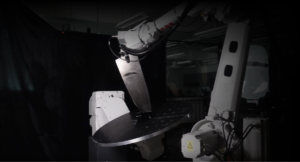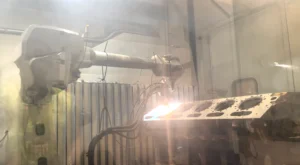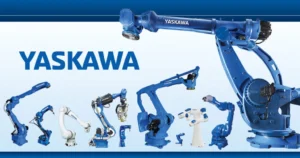table of contents
- Heading 1
- Heading 1
- Heading 1
share this
You cannot underestimate the role of KUKA robots in industries such as automobiles and electronics. It provides the precision and reliability these industries demand. If you are using robots to create new products or modify old ones, you will require an understanding of their programming language. You don’t need to be a seasoned engineer to benefit from this blog; a curious mind is all you need. Let’s start with how to program a KUKA robot.
5 Ways to Program a KUKA Robot
Designing a KUKA robot can seem like an uphill task. But with the right tools and know-how, it’s easy and even enjoyable at times. Here are five basic ways to program this versatile machine.
1. Teach Pendant:
Kuka’s Teach Pendant is called smartPAD. This portable unit allows you to program the robot directly and edit it if needed. This device is for everyone– it’s simple, hands-on, and perfect for understanding how to control robots. The smartPAD is important in simple tasks and when you need to make quick changes.
Using the smartPAD implies a simpler operation. It uses 8 separate jog keys to control the robot’s axes without switching. Its interface is intuitive, typically including a touchscreen and manual controls. This makes it accessible even to those with little programming experience.
2. KUKA Robot Language (KRL):
KRL is the main programming language for the KUKA robot. This KUKA programming language is strong, powerful, and specially designed for industrial applications. Compared to other robotic programming languages, KRL provides precise control and optimization for KUKA hardware. However, it is difficult to master this language.
The KRL syntax is somewhat similar to Pascal, which some programmers may be familiar with. But KRL is specially made and structured to be compatible with robot programming. So it provides extensive abilities for tricky tasks.
3. Hand Guiding:
The tool used for KUKA’s ready2_pilot (hand-guiding system), is called the Commander. This is not to be confused with the 6D mouse on the smartPAD used for manual jogging. With the Commander, you can guide the robot in its movements and record the motion in the system. This approach is intuitive and eliminates the need for advanced programming skills. Manual guidance is useful for tasks requiring excellent accuracy. It is ideal for applications like welding or assembly, where the specific orientation and speed of the robot are important.
4. Graphical Offline Programming:
With tools like KUKA.WorkVisual and KUKA.Sim you can create and test programs on your computer before running them on the robot. You can also simulate robotic tasks in a virtual environment using offline systems. This method works well and helps detect faults early.
5. API and Third-Party Software:
You can use third-party software like Augmentus and RoboDK to program the KUKA robot. These platforms offer great flexibility. Third-party software normally contains more supporting tools than the main one.
These enhance the capabilities and user-friendliness of the robots, making it easier to adapt KUKA robots to specific technical needs.
Things to Consider When Programming a KUKA Robot
When programming a KUKA robot, there are several things to keep in mind for a smooth experience:
1. Safety:
Always put safety first. Integrate emergency stops and safety interlocks into your program to quickly halt the work if something goes wrong. KUKA robots come with a variety of safety features. There are times, however, when additional features are needed to prevent accidents and to maintain the safety of users and the environment.
2. Precision:
KUKA robots are known for their precision. To achieve this, follow best practices such as proper calibration, clear path planning, and thorough testing. Use detailed documentation to track changes and corrections. Use simulation tools such as KUKA.Sim and Augmentus to test your systems in a virtual environment before deployment. This ensures accuracy and performance.
3. Compatibility:
Not all third-party software can support every aspect of the KUKA robot. The software you choose should be compatible with the KUKA robot model you have. The best software for a KUKA robot system will depend on your specific needs and your knowledge of available tools.
4. Training:
Invest time in training. Whether it’s an official KUKA course or on third-party resources, developing a solid understanding of the tools and languages will pay off in the long run. Continually learning and staying updated with the latest software and programming techniques can increase your programming efficiency substantially.
How to Program a KUKA Robot Quickly and Easily
Programming a KUKA robot doesn’t have to be a lengthy process. Here’s how you can streamline it:
Use Intuitive tools:
The KUKA smartPAD makes your life easier with an easy-to-use interface, especially when you need to program complex tasks. With the help of inline forms, you can program without requiring in-depth technical knowledge. The smartPAD’s interface is designed to reduce the learning curve and allow quick changes and modifications to the robotic system.
Use Intuitive tools:
The KUKA smartPAD makes your life easier with an easy-to-use interface, especially when you need to program complex tasks. With the help of inline forms, you can program without requiring in-depth technical knowledge. The smartPAD’s interface is designed to reduce the learning curve and allow quick changes and modifications to the robotic system.
Benefitting from online tools:
KUKA.WorkVisual and KUKA.Sim allows you to program and simulate offline tasks. This catches errors before they reach the robot. These tools provide a comprehensive environment for developing, testing, and optimizing systems. A properly tested and optimized code will ensure fewer to no changes during real-time installation.
Modular Programming:
KUKA.AppTech offers pre-built modules that can be easily integrated into your programs. As a result, your time is saved while also reducing the complexity of your code. Another advantage of modular programming is that it allows users to create blocks of code that can be reused. This makes it easier to maintain and update programs as needed. This approach is particularly useful for complex systems that require frequent adaptations and modifications.
Ready2_pilot:
This handy tool allows you to teach the robot with a Commander , making programming quick and easy. Additionally, the process can be greatly simplified using APIs and third-party software such as Augmentus. Augments provides a drag-and-drop interface that simplifies programming. This makes it accessible to professionals with a variety of technical backgrounds.
Conclusion
Arc welding is almost everywhere, used in one method or the other. Each type of arc welding method offers unique advantages and fits perfectly for specific applications. As industries advance, achieving quality welds at high efficiency and safety becomes a norm.
Robotic systems have revolutionized arc welding, meeting the growing demands of modern industries. To stay competitive, companies must adapt to these advancements. Discover how Augmentus’ vision-guided offline robot programming software can significantly enhance your arc welding operations. Schedule a demo today!
FAQs
1. What programming language do KUKA robots use?
KUKA programming language is the KUKA Robot Language (KRL).
2. How does KUKA Robot Language (KRL) compare to other robot programming languages?
KRL is made for KUKA hardware and offers precise control commands for complex tasks.
3. Can I use third-party software to program KUKA robots?
Yes, third-party software like Augmentus can be used to program KUKA robots.
4. What is the difference between KUKA and FANUC robots?
KUKA robots are known for their precision and user-friendly software, while FANUC robots are praised for their extensive application range.
5. Which is the best software for KUKA robot programming?
Choosing the best KUKA robot programming software largely depends on your needs and familiarity with existing equipment. Nonetheless, due to their advanced capabilities and compatibility with KUKA robots, KUKA.WorkVisual and KUKA.Sim is widely used.



